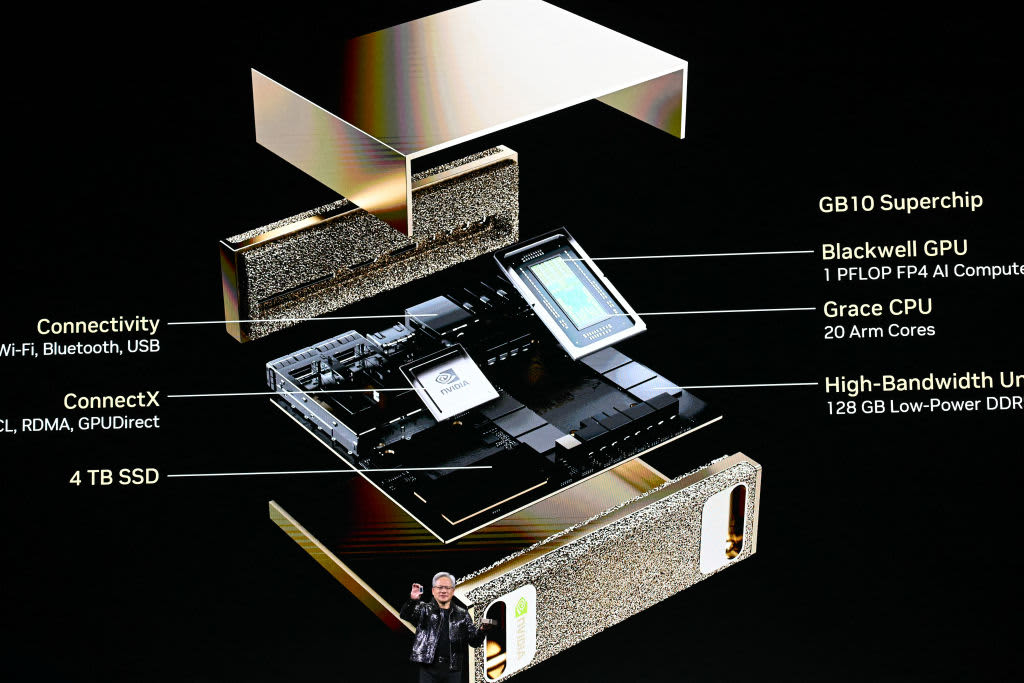Nvidiaboom that’s made the chipmaker the second-most-valuable company in the world.
At his nearly two-hour keynote on Monday kicking off the annual tech conference, Huang packed a 12,000-seat arena, drawing comparisons to the way the late Steve Jobs revealed products at Apple
Huang concluded with an Apple-like trick: a surprise product reveal. He presented one of Nvidia’s server racks and, using some stage magic, held up a much smaller version, which looked like a tiny cube of a computer.
“This is an AI supercomputer,” said Huang, wearing an alligator-skin leather jacket. “It runs the entire Nvidia AI stack. All of Nvidia’s software runs on this.”
Huang said the computer is called Project Digits and runs off a relative of the Grace Blackwell graphics processing units, or GPUs, that are currently powering the most advanced AI server clusters. The GPU is paired with an ARMMediaTek to create the system-on-a-chip called GB10.
Formerly known as the Consumer Electronics Show, CES is typically the spot to launch flashy and futuristic consumer gadgets. At this year’s show, which started Tuesday and wraps up Friday, several companies announced AI integrations with appliances, laptops and even grills. Other major announcements included a laptop from Lenovo with a rollable screen that can expand vertically. There were also new robots, including a Roomba competitor with a robotic arm.
Unlike Nvidia’s traditional GPUs for gaming, Project Digits isn’t targeting consumers. Instead, it’s aimed at machine-learning researchers, smaller companies, and universities that want to develop advanced AI but don’t have billions of dollars to build massive data centers or buy enough cloud credits.
“There’s a gaping hole for data scientists and ML researchers and who are actively working, who are actively building something,” Huang said. “Maybe you don’t need a giant cluster. You’re just developing the early versions of the model, and you’re iterating constantly. You could do it in the cloud, but it just costs a lot more money.”
The supercomputer will cost about $3,000 when it hits the market in May, Nvidia said, and it will be available from the company itself as well as some of its manufacturing partners. Huang said Project Digits is a placeholder name, indicating it may change by the time the computer goes on sale.
“If you have a good name for it, reach out to us,” Huang said.
Diversifying its business
It’s a dramatically different kind of product from the GPUs that have driven Nvidia’s historic boom in the past two years. OpenAI, which launched ChatGPT in late 2022, and other AI model creators such as Anthropic have joined with large cloud providers in snapping up Nvidia’s data center GPUs because of their ability to power the most intensive models and computing workloads.
Data center sales accounted for 88% of Nvidia’s $35 billion in revenue in the most recent quarter.
Wall Street is focused on Nvidia’s ability to diversify its business so that it’s less reliant on a handful of customers buying massive AI systems.
“It was a little scary to see Nvidia come out with something so good for so little in price,” Melius Research analyst Ben Reitzes wrote in a note this week. He said Nvidia may have “stolen the show,” due to Project Digits as well as other announcements, including graphics cards for gaming, new robot chips and a deal with Toyota
Project Digits, which runs Linux and the same Nvidia software used on the company’s GPU server clusters, represents a huge increase in capabilities for researchers and universities, said David Bader, director of the Institute for Data Science at New Jersey Institute of Technology.
Bader, who has worked on research projects with Nvidia in the past, said the computer appears to be able to handle enough data and information to train the biggest and most cutting-edge models. He told CNBC that Anthropic, GoogleAmazon
For $3,000, users can soon get a product they can plug into a standard electrical outlet in their home or office, Bader said. It’s particularly exciting for academics, who have often left for private industry in order to access bigger and more powerful computers, he said.
“Any student who is able to have one of these systems that cost roughly the same as a high-end laptop or gaming laptop, they’ll be able to do the same research and build the same models,” Bader said.
Reitzes said the computer may be Nvidia’s first move into the $50 billion market for PC and laptop chips.
“It’s not too hard to imagine it would be easy to just do it all themselves and allow the system to run Windows someday,” Reitzes wrote. “But I guess they don’t want to step on too many toes.”
Huang didn’t rule out that possibility when asked about it by Wall Street analysts Tuesday.
He said MediaTek may be able to sell the GB10 chip to other computer makers in the market. He made sure to leave some mystery in the air.
“Obviously, we have plans,” Huang said.
International: Top News And Analysis
Read the full article <a href="Read More” target=”_blank”>here.


